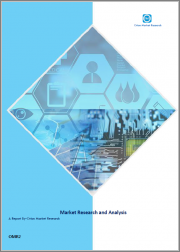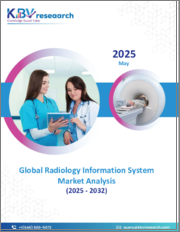
|
시장보고서
상품코드
1380414
세계의 방사선 정보 시스템 시장(2023-2030년)Global Radiology Information System Market 2023-2030 |
||||||
세계 방사선 정보 시스템 시장은 예측 기간 동안 CAGR 6.5%의 높은 성장률을 보일 것으로 예상됩니다. 방사선 정보 시스템의 지속적인 기술 발전은 시장 성장을 가속하는 중요한 요인입니다. 만성 질환의 유병률 증가와 의료비 지출 증가는 세계적으로 시장을 주도하는 또 다른 요인입니다. 세계보건기구(WHO)에 따르면 암은 세계 주요 사망 원인으로 2020년 사망자 수는 약 1,000만 명으로 사망자 6명 중 1명을 차지할 것으로 예상됩니다. 그 중 유방암, 폐암, 대장암, 직장암, 전립선암이 가장 많습니다. 또한 2021년 7월에 업데이트된 국제암연구소(IARC)의 추정에 따르면, 2040년까지 세계적으로 암으로 인한 사망자가 2,750만 명, 암으로 인한 사망자가 1,630만 명에 달할 것으로 예상했습니다.
2021년 7월, 호주 및 뉴질랜드는 방사선 정보 시스템을 클라우드 기반 의료 예약 시스템에 통합하기 위해 협력했습니다. 온라인 플랫폼을 통해 환자는 방사선과 진료소에 전화하지 않고도 진단 날짜와 시간을 선택할 수 있습니다. 또한 환자가 원하는 장소를 선택할 수 있어 예약 절차가 더욱 쉽고 편리해집니다. 이러한 신흥국 시장 개척이 세계 시장 성장을 주도하고 있습니다.
부문별 전망
클라우드 기반이 세계 방사선 정보 시스템 시장에서 괄목할 만한 성장세를 보일 것으로 전망
클라우드 기반 부문은 예측 기간 동안 큰 성장을 보일 것으로 예상됩니다. 클라우드 기반 소프트웨어가 온프레미스에 비해 가격이 저렴하다는 점이 이 시장 부문의 성장을 가속하는 주요 요인입니다. 가입자는 전체 모델을 구입하는 대신 최신 버전을 저렴한 가격으로 이용할 수 있습니다. 데이터는 외부 서버에 저장되기 때문에 클라우드 기반 솔루션은 온라인 액세스가 용이하며, AI 알고리즘을 클라우드 기반 방사선 정보 시스템과 결합하여 완벽한 소프트웨어를 만들 수 있습니다. 이러한 AI 기술은 다른 AI 도구와 결합하여 의사가 환자를 더 빠르고 정확하게 진단할 수 있도록 도와줍니다.
클라우드 기반 방사선 정보 시스템은 경제적이기 때문에 고가의 하드웨어에 투자할 여력이 없는 중소형 병원에 특히 적합합니다. 또한 클라우드 기반 방사선 정보 시스템은 의료진이 환자 정보에 접근할 수 있는 사람을 관리할 수 있기 때문에 보안을 강화할 수 있습니다.
지역별 전망
세계 방사선 정보 시스템 시장은 북미(미국 및 캐나다), 유럽(이탈리아, 스페인, 독일, 프랑스, 기타), 아시아태평양(인도, 중국, 일본, 한국, 기타), 기타 지역(중동 및 아프리카, 라틴아메리카) 등 지역별로 세분화되어 있습니다. 전체 지역 중 아시아태평양이 세계 시장에서 큰 비중을 차지할 것으로 예상됩니다. 신흥 경제권에서 방사선 정보 시스템 도입이 확대되고 있는 것이 이 지역 시장의 성장을 가속하는 주요 요인으로 작용하고 있습니다. 방사선 정보 시스템의 지속적인 기술 발전은 이 지역 시장을 더욱 견인하고 있습니다.
북미, 세계 방사선 정보 시스템 시장에서 큰 점유율을 차지합니다.
잘 구축된 의료 인프라의 존재, 노인 인구 증가, 질병의 조기 진단에 대한 환자의 높은 인식이 이 지역 시장 성장을 가속하는 주요 요인으로 작용하고 있습니다. 예를 들어, 2023년 5월 미국병원협회가 실시한 미국 내 병원 연례조사에 따르면, 미국 내 병원 수는 총 6,129개이며, 이 중 5,157개는 지역 병원으로 보고됐습니다. 수많은 진단센터의 존재, 대상 질환의 유병률 증가, 의료비 지출 증가, 기술적으로 진보된 영상 시스템 채택은 지역 시장의 높은 점유율에 더욱 기여하고 있습니다.
목차
제1장 보고서 개요
- 업계 현황 분석과 성장 가능성 전망
- 조사 방법과 툴
- 시장 내역
- 부문별
- 지역별
제2장 시장 개요와 인사이트
- 조사 범위
- 애널리스트 인사이트와 현재 시장 동향
- 주요 조사 결과
- 추천 사항
- 결론
제3장 경쟁 구도
- 주요 기업 분석
- Allscripts Healthcare Solutions Inc.
- 개요
- 재무 분석
- SWOT 분석
- 최근 동향
- Cerner Corp.
- 기업 개요
- 재무 분석
- SWOT 분석
- 최근 동향
- IBM(Merge Healthcare Inc.)
- 개요
- 재무 분석
- SWOT 분석
- 최근 동향
- Koninklijke Philips N.V.
- 개요
- 재무 분석
- SWOT 분석
- 최근 동향
- Siemens Healthineers
- 개요
- 재무 분석
- SWOT 분석
- 최근 동향
- 주요 전략 분석
제4장 시장 세분화
- 세계의 방사선 정보 시스템 시장 : 전개 모드별
- 온프레미스
- 클라우드 기반
- 세계의 방사선 정보 시스템 시장 : 유형별
- 스탠드얼론형 방사선 정보 시스템
- 통합형 방사선 정보 시스템
- 세계의 방사선 정보 시스템 시장 : 컴포넌트별
- 하드웨어
- 소프트웨어
- 서비스
제5장 지역 분석
- 북미
- 미국
- 캐나다
- 유럽
- 영국
- 독일
- 이탈리아
- 스페인
- 프랑스
- 기타 유럽
- 아시아태평양
- 중국
- 인도
- 일본
- 한국
- 기타 아시아태평양
- 기타 지역
제6장 기업 개요
- Altran
- Ambra Health
- Carestream Health
- Epic Systems Corp.
- GE Healthcare
- INFINITT North America Inc.
- JVCKENWOOD USA Corp.
- Kareo
- Konica Minolta Healthcare Americas Inc.
- Mckesson Corp.
- Medinformatix Inc.
- NextGen Healthcare
- patientNOW Inc.
- Practice Fusion
- RedRick Technologies Inc.
- Varian Medical Systems Inc
Title: Global Radiology information system Market Size, Share & Trends Analysis Report by Type (Integrated Radiology Information System and Stand-alone Radiology Information System), by Deployment Mode (On-Premises and Cloud-Based), and by Component (Hardware, Software, and Services)Forecast Period (2023-2030).
The global radiology information system market is anticipated to grow at a significant CAGR of 6.5% during the forecast period. The ongoing technological advancements in radiology information systems is a key factor driving the growth of the market. The rising prevalence of chronic disorders coupled with the rising healthcare expenditure are some other factors which are driving the market globally. According to the World Health Organization (WHO), cancer was a leading cause of mortality around the globe, accounting for nearly 10 million mortalities in 2020, or nearly one in six fatalities. Amongst these, the most common type of cancers were breast, lung, colon and rectum and prostate cancers. Additionally, according to estimates from the International Agency for Research on Cancer (IARC) updates from July 2021, the global burden of cancers is expected to grow to 27.5 million new cancer cases and 16.3 million fatalities globally by 2040.
In July 2021, Australia-New Zealand collaborated to integrate radiology information system with cloud-based health booking system. Through the online platform, patients can pick a date and time of their diagnostics without the need to call a radiology practice. They can also choose their preferred location, making the booking process easier and more convenient. Such developments are driving the growth of the global market.
Segmental Outlook
The global radiology information system market is segmented based on component, deployment mode, and type. Based on component, the market is segmented into hardware, software, and services. Based on deployment mode, the market is segmented into on-premises and cloud based. Based on type, the market is segmented into integrated radiology information system, and stand-alone radiology information system.
Cloud-Based is anticipated to Exhibit Considerable Growth in the Global Radiology Information System Market
The cloud-based segment is anticipated to exhibit significant growth during the forecast period. The affordability of cloud-based software compared to on-premises is a key factor driving the growth of this market segment. Instead of purchasing the entire model, consumers can subscribe to the latest version at a low price. Online accessibility is facilitated by cloud-based solutions since data is kept on external servers. AI algorithms can be combined with cloud-based radiological information systems to create complete software. These AI technologies can be coupled with any other AI tool and enable doctors to diagnose patients more quickly and accurately.
As cloud-based radiology information system is economic, they are especially well-suited for small to medium-sized hospitals that cannot afford to invest in expensive hardware. Furthermore, cloud-based radiology information system gives medical practitioners the ability to manage who has access to patient information, improving security.
Regional Outlook
The global radiology information system market is further segmented based on geography, including North America (the US and Canada), Europe (Italy, Spain, Germany, France, and others), Asia-Pacific (India, China, Japan, South Korea, and others), and the Rest of the World (the Middle East & Africa and Latin America). Among all the regions, Asia-Pacific is anticipated to exhibit considerable share on the global market. The growing adoption of radiology information system in emerging economies is a key factor driving the growth of the regional market. The on-going technological advancements in radiology information system is further driving the regional market.
North America Held Considerable Share in the Global Radiology Information System Market
The presence of well-established healthcare infrastructure, growing geriatric population, and high awareness among patients towards early diagnosis of diseases are major factors driving the regional market growth. For instance, in May 2023, the American Hospital Association's annual survey of hospitals in the US reports a total of 6,129 hospitals in the country, with 5,157 of them being community hospitals. The presence of a large number of diagnostic centers, growing prevalence of targeted diseases, rising healthcare expenditure, and adoption of technologically advanced imaging systems are further aiding to high share of the regional market.
Market Players Outlook
The major companies serving the global radiology information system market include: Allscripts Healthcare Solutions Inc., Cerner Corp., IBM (Merge Healthcare Inc.), Koninklijke Philips N.V., and Siemens Healthineers among others. The market players are considerably contributing to the market growth by the adoption of various strategies, including mergers and acquisitions, partnerships, collaborations, funding, and new product launches, to stay competitive in the market. For instance, in March 2022, Intelerad Medical Systems launched the Enterprise Imaging and Informatics Suite at the 2022 Healthcare Information and Management Systems Society (HIMSS) Global Health Conference and Exhibition, which may provide radiologists with an emerging option for medical image management.
The Report Covers:
- Market value data analysis of 2022 and forecast to 2030.
- Annualized market revenues ($ million) for each market segment.
- Country-wise analysis of major geographical regions.
- Key companies operating in the global radiology information system market. Based on the availability of data, information related to new product launches, and relevant news is also available in the report.
- Analysis of business strategies by identifying the key market segments positioned for strong growth in the future.
- Analysis of market-entry and market expansion strategies.
- Competitive strategies by identifying 'who-stands-where' in the market.
Table of Contents
1. Report Summary
- Current Industry Analysis and Growth Potential Outlook
- 1.1. Research Methods and Tools
- 1.2. Market Breakdown
- 1.2.1. By Segments
- 1.2.2. By Region
2. Market Overview and Insights
- 2.1. Scope of the Report
- 2.2. Analyst Insight & Current Market Trends
- 2.2.1. Key Findings
- 2.2.2. Recommendations
- 2.2.3. Conclusion
3. Competitive Landscape
- 3.1. Key Company Analysis
- 3.2. Allscripts Healthcare Solutions Inc.
- 3.2.1. Overview
- 3.2.2. Financial Analysis
- 3.2.3. SWOT Analysis
- 3.2.4. Recent Developments
- 3.3. Cerner Corp.
- 3.3.1. Overview
- 3.3.2. Financial Analysis
- 3.3.3. SWOT Analysis
- 3.3.4. Recent Developments
- 3.4. IBM (Merge Healthcare Inc.)
- 3.4.1. Overview
- 3.4.2. Financial Analysis
- 3.4.3. SWOT Analysis
- 3.4.4. Recent Developments
- 3.5. Koninklijke Philips N.V.
- 3.5.1. Overview
- 3.5.2. Financial Analysis
- 3.5.3. SWOT Analysis
- 3.5.4. Recent Developments
- 3.6. Siemens Healthineers
- 3.6.1. Overview
- 3.6.2. Financial Analysis
- 3.6.3. SWOT Analysis
- 3.6.4. Recent Developments
- 3.7. Key Strategy Analysis
4. Market Segmentation
- 4.1. Global Radiology Information System Market by Deployment Mode
- 4.1.1. On-Premises
- 4.1.2. Cloud-Based
- 4.2. Global Radiology Information System Market by Type
- 4.2.1. Standalone Radiology Information System
- 4.2.2. Integrated Radiology Information System
- 4.3. Global Radiology Information System Market by Component
- 4.3.1. Hardware
- 4.3.2. Software
- 4.3.3. Services
5. Regional Analysis
- 5.1. North America
- 5.1.1. United States
- 5.1.2. Canada
- 5.2. Europe
- 5.2.1. UK
- 5.2.2. Germany
- 5.2.3. Italy
- 5.2.4. Spain
- 5.2.5. France
- 5.2.6. Rest of Europe
- 5.3. Asia-Pacific
- 5.3.1. China
- 5.3.2. India
- 5.3.3. Japan
- 5.3.4. South Korea
- 5.3.5. Rest of Asia-Pacific
- 5.4. Rest of the World
6. Company Profiles
- 6.1. Altran
- 6.2. Ambra Health
- 6.3. Carestream Health
- 6.4. Epic Systems Corp.
- 6.5. GE Healthcare
- 6.6. INFINITT North America Inc.
- 6.7. JVCKENWOOD USA Corp.
- 6.8. Kareo
- 6.9. Konica Minolta Healthcare Americas Inc.
- 6.10. Mckesson Corp.
- 6.11. Medinformatix Inc.
- 6.12. NextGen Healthcare
- 6.13. patientNOW Inc.
- 6.14. Practice Fusion
- 6.15. RedRick Technologies Inc.
- 6.16. Varian Medical Systems Inc



















